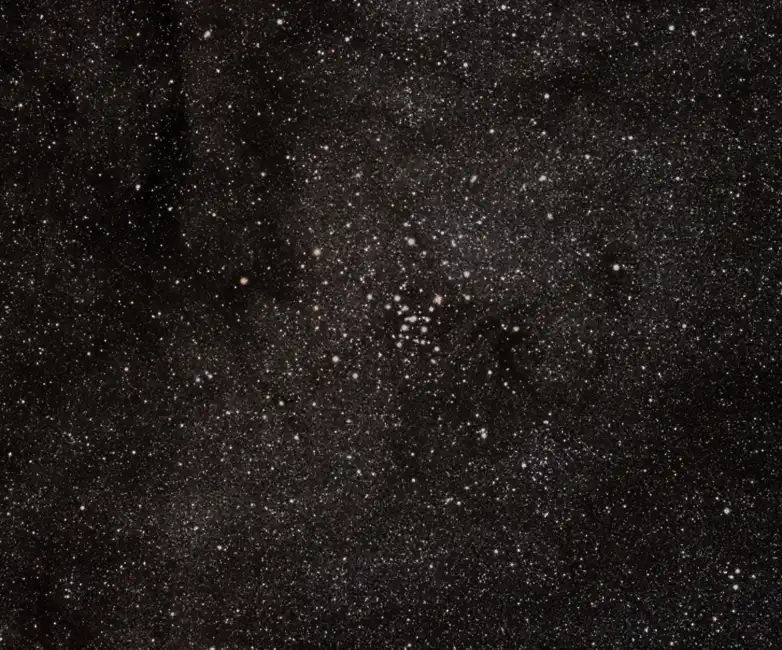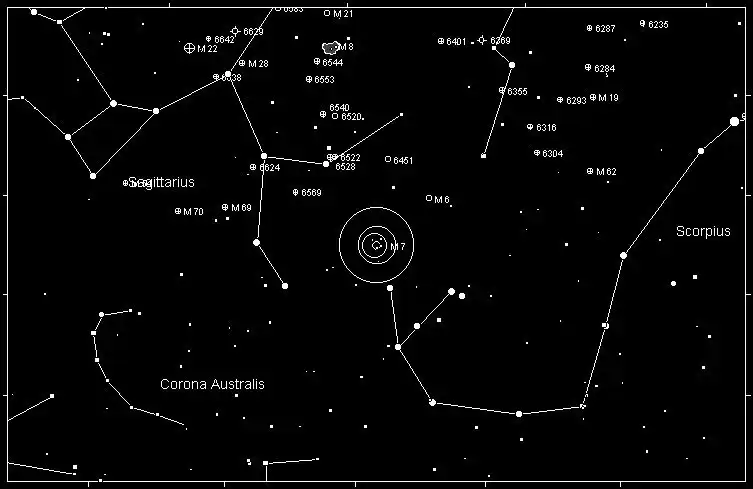Messier 7, also known as the Ptolemy Cluster or NGC 6475, is a striking open star cluster located in the constellation Scorpius. This bright and prominent cluster contains around 80 stars, with an estimated age of 200 million years. Spanning approximately 25 light-years across, Messier 7 sits around 800 to 1,000 light-years away from Earth, making it one of the closest open clusters visible to the naked eye. Its stars shine primarily blue and white, hinting at their relatively young age.
Visually, Messier 7 is a stunning cluster, with its brightest stars creating a distinctive shape resembling a small kite or arrowhead. The stars vary in brightness, creating a beautiful display that amateur astronomers often describe as "sparkling" against the backdrop of the Milky Way.
Magnitude
Messier 7 has an apparent magnitude of +3.3, making it easily visible under dark skies without any optical aid. It’s one of the few Messier objects that can be seen with the naked eye, even in areas with mild light pollution. With binoculars or a small telescope, the cluster reveals dozens of stars, making it a favorite target for amateur astronomers.

Prominent Season and Constellation
Messier 7 is best observed in the summer months when the constellation Scorpius, in which it resides, dominates the southern sky. In the Northern Hemisphere, June through August is the ideal time to view this cluster as Scorpius is high in the sky during these months. In the Southern Hemisphere, Messier 7 can be observed from late autumn through winter, with its highest visibility occurring from May to September.
Location and How to Find It with a Telescope
Messier 7 is situated in the "tail" of Scorpius, close to the bright star Shaula, which marks the stinger of the Scorpion. To locate Messier 7, start by finding the prominent red star Antares, which marks the heart of the Scorpion. From Antares, follow the arc of the constellation downwards toward the southern horizon. You’ll come across two bright stars, Shaula and Lesath, which form the Scorpion's sting. Just a few degrees northwest of these stars lies Messier 7.
Using binoculars or a small telescope with a low magnification setting will give you the best view. With a telescope, even at lower magnification, you can resolve many individual stars in the cluster. For more detail, increase magnification slightly, but be mindful not to lose the cluster’s overall context within its surroundings in the Milky Way.

History
Messier 7 has a rich observational history that spans back to antiquity. The Greek-Egyptian astronomer Claudius Ptolemy was one of the first to catalog the cluster in the 2nd century, describing it as a "nebula following the sting of Scorpius." This early reference earned it the name "Ptolemy's Cluster." Ptolemy’s description was significant for its time, as the term “nebula” referred to any extended celestial object that wasn’t a point source, which included star clusters like Messier 7.
Later, in 1654, the Italian astronomer Giovanni Battista Hodierna made detailed observations of the cluster, recognizing it as a collection of individual stars rather than a nebula. However, Messier 7 did not gain wide attention until Charles Messier included it in his famous catalog of nebulous objects in 1764. He listed it as the seventh entry, describing it as a bright cluster of stars visible to the naked eye.
In modern astronomy, Messier 7 continues to be a well-studied object, contributing to our understanding of stellar evolution and the dynamics of open star clusters. Its brightness and proximity make it an ideal target for studying young stars and their formation processes.
Conclusion
Messier 7, the Ptolemy Cluster, is a beautiful and historic open star cluster located in the constellation Scorpius. With its easy visibility to the naked eye, binoculars, or small telescopes, it has captivated observers for centuries. Visible during summer nights in the Northern Hemisphere and winter months in the Southern Hemisphere, Messier 7 is a prime target for stargazers. Its place in the history of astronomy, stretching back to Ptolemy’s time, adds to its allure as one of the night sky’s jewels.
